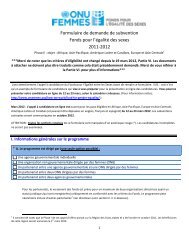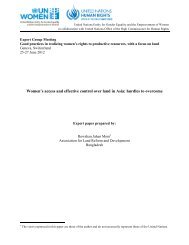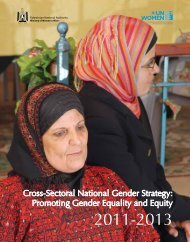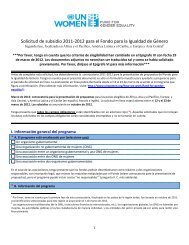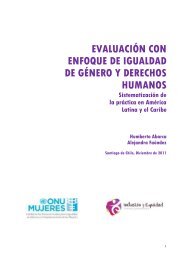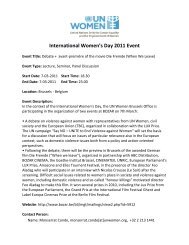Informal Justice Systems: Charting a Course for Human - UN Women
Informal Justice Systems: Charting a Course for Human - UN Women
Informal Justice Systems: Charting a Course for Human - UN Women
You also want an ePaper? Increase the reach of your titles
YUMPU automatically turns print PDFs into web optimized ePapers that Google loves.
cHaPTer i<br />
30<br />
the definition also imposes certain necessary limitations. systems of great importance <strong>for</strong> the maintenance of law<br />
and order, local security and ‘protection’ are not within the scope of this study. 2 Because the distinction between<br />
security and justice in in<strong>for</strong>mal systems can be very fluid, this limitation is unavoidable. the country studies looked<br />
at rural or peri-urban areas rather than typically urban settings. the limitations that this causes <strong>for</strong> the kinds of systems<br />
studied are likewise acknowledged; <strong>for</strong> example, phenomena such as ‘town chiefs’ are not studied in depth.<br />
the study also does not deal with systems used by outlawed organizations or ad hoc groups <strong>for</strong> maintaining internal<br />
order. While the administration of sets of rules by commercial or professional organizations could in principle<br />
fit into the definition, such systems did not <strong>for</strong>m part of the study. the definition also excludes processes and<br />
practices by <strong>for</strong>mal justice sector actors who may employ alternative dispute resolution (aDr). 3 While this study<br />
does not treat these as ijs, the country studies and the main study analyse linkages between <strong>for</strong>mal and in<strong>for</strong>mal<br />
justice processes.<br />
<strong>for</strong>maLity and in<strong>for</strong>maLity<br />
it is more correct to speak of a continuum between in<strong>for</strong>mal and <strong>for</strong>mal justice providers or systems than of a sharp<br />
set of distinctions. the continuum ranges from different degrees of state recognition and interaction, accountability,<br />
monitoring and supervision by the state, referral mechanisms and guiding legal or normative frameworks. the<br />
systems encountered in the context of this study and the literature on this subject show that the notion of ‘<strong>for</strong>mality’<br />
has different aspects. <strong>for</strong>mality can be measured by different parameters, of which state recognition is only<br />
one. other parameters include written versus oral procedures and records; written versus oral substantive norms;<br />
the degree to which the system favours con<strong>for</strong>mity with rules rather than finding solutions satisfactory to the two<br />
parties; the binding or non-binding nature of outcomes (as seen by state law); and the stability and durability of<br />
the structures and procedures.<br />
this study does not proceed from the assumption of a dichotomy between ‘state’ and ‘non-state’, as many of the<br />
systems most used by people have a basis both in state law and regulation or in other <strong>for</strong>ms of state recognition. 4<br />
nevertheless, the state/non-state dichotomy is frequently the basis <strong>for</strong> understanding the separation between the<br />
two spheres that is shared by communities and officials, and it thus cannot be disregarded. so the study attempts<br />
to attenuate such a sharp dichotomy by using a ‘continuum of <strong>for</strong>mality’: in<strong>for</strong>mality that includes the state/nonstate<br />
dichotomy, but does not rely upon it exclusively. the section on the conceptual framework defines this further.<br />
it is emphasized that no value judgment is intended by the use of the word ‘in<strong>for</strong>mal’.<br />
LegaL pLuraLism<br />
this study posits legal pluralism as a fact. such pluralism exists when sets of norms and institutions that people use<br />
to regulate conduct derive from sources other than state legislation and jurisprudence, and many states legally recognize<br />
these. even in the absence of state recognition, there are many norms and institutions in all countries. this<br />
is particularly apparent in post-colonial states. the study recognizes that custom and society are ever changing.<br />
Pluralism can engender tension in the different sources of legitimacy existing with a state, ranging from legitimacy<br />
based on elections, lineage, local authority or on religious faith and learning.<br />
2 <strong>for</strong> an excellent recent treatment of non-state security systems in developing countries, see Baker, 2010.<br />
3 ‘in<strong>for</strong>mal justice systems’ are distinct from alternative dispute resolution. the latter would include in<strong>for</strong>mal practices and processes<br />
by the <strong>for</strong>mal system. the commission of the legal empowerment of the Poor defines in<strong>for</strong>mal justice differently, placing<br />
government-affiliated third-party arbitration systems under the rubric of in<strong>for</strong>mal justice. <strong>for</strong> purposes of policy-making and<br />
programming, though, it may be relevant to make a clearer distinction with the aid of different terminology <strong>for</strong> these practices<br />
and processes. in many countries, and particularly in european and other Western countries, such practices are termed ‘alternative<br />
dispute resolution’.<br />
4 on the various parameters that are of relevance in relation to legal pluralism, de sousa santos uses official/unofficial,<br />
<strong>for</strong>mal/in<strong>for</strong>mal, traditional/modern and monocultural/multicultural. see de sousa santos, B., 2006.<br />
a stuDy of in<strong>for</strong>mal justice systems: access to justice anD human rights



